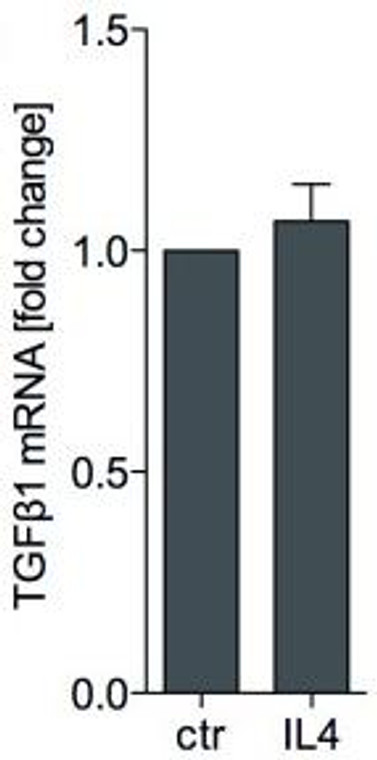| Host: |
CHO cells |
| Note: |
STRICTLY FOR FURTHER RESEARCH USE ONLY (RUO). MUST NOT TO BE USED IN DIAGNOSTIC OR THERAPEUTIC APPLICATIONS. |
| Short Description: |
Recombinant-Human TGF Beta-2-protein was developed from cho cells. For use in research applications. |
| Conjugation: |
Unconjugated |
| Formulation: |
Lyophilised from 0.2 Mu m filtered PBS solution pH7.4. |
| Dilution Range: |
Spin the vial and reconstite in distilled water to a concentration not less than 0.1 mg/mL. This can then be diluted into other buffers. |
| Storage Instruction: |
Can be stored in working aliquots at°C-°C C for one month, or at-20°C C for six months. Avoid repeated freeze/thaw cycles. NA |
| Endotoxin: |
Endotoxin content was assayed using a LAL gel clot method. Endotoxin level was found to be less than.1 ng/µg (1EU/µg). NA |
| Gene Symbol: |
TGFB1 |
| Gene ID: |
7040 |
| Uniprot ID: |
TGFB1_HUMAN |
| Immunogen Region: |
Mature chain |
| Immunogen: |
Optimized DNA sequence encoding Human Transforming Growth Factor Beta-2 mature chain was expressed in CHO Cells NA |
| Immunogen Sequence: |
MPPSGLRLLL LLLPLLWLLV LTPGRPAAGL STCKTIDMEL VKRKRIEAIR GQILSKLRLA SPPSQGEVPP GPLPEAVLAL YNSTRDRVAG ESAEPEPEPE ADYYAKEVTR VLMVETHNEI YDKFKQSTHS IYMFFNTSEL REAVPEPVLL SRAELRLLRL KLKVEQHVEL YQKYSNNSWR YLSNRLLAPS DSPEWLSFDV TGVVRQWLSR GGEIEGFRLS AHCSCDSR |
| Tissue Specificity | Highly expressed in bone. Abundantly expressed in articular cartilage and chondrocytes and is increased in osteoarthritis (OA). Colocalizes with ASPN in chondrocytes within OA lesions of articular cartilage. |
| Post Translational Modifications | Transforming growth factor beta-1 proprotein: The precursor proprotein is cleaved in the Golgi apparatus by FURIN to form Transforming growth factor beta-1 (TGF-beta-1) and Latency-associated peptide (LAP) chains, which remain non-covalently linked, rendering TGF-beta-1 inactive. Latency-associated peptide: N-glycosylated. Deglycosylation leads to activation of Transforming growth factor beta-1 (TGF-beta-1).mechanisms triggering deglycosylation-driven activation of TGF-beta-1 are however unclear. |
| Function | Transforming growth factor beta-1 proprotein: Precursor of the Latency-associated peptide (LAP) and Transforming growth factor beta-1 (TGF-beta-1) chains, which constitute the regulatory and active subunit of TGF-beta-1, respectively. Latency-associated peptide: Required to maintain the Transforming growth factor beta-1 (TGF-beta-1) chain in a latent state during storage in extracellular matrix. Associates non-covalently with TGF-beta-1 and regulates its activation via interaction with 'milieu molecules', such as LTBP1, LRRC32/GARP and LRRC33/NRROS, that control activation of TGF-beta-1. Interaction with LRRC33/NRROS regulates activation of TGF-beta-1 in macrophages and microglia (Probable). Interaction with LRRC32/GARP controls activation of TGF-beta-1 on the surface of activated regulatory T-cells (Tregs). Interaction with integrins (ITGAV:ITGB6 or ITGAV:ITGB8) results in distortion of the Latency-associated peptide chain and subsequent release of the active TGF-beta-1. Transforming growth factor beta-1: Multifunctional protein that regulates the growth and differentiation of various cell types and is involved in various processes, such as normal development, immune function, microglia function and responses to neurodegeneration. Activation into mature form follows different steps: following cleavage of the proprotein in the Golgi apparatus, Latency-associated peptide (LAP) and Transforming growth factor beta-1 (TGF-beta-1) chains remain non-covalently linked rendering TGF-beta-1 inactive during storage in extracellular matrix. At the same time, LAP chain interacts with 'milieu molecules', such as LTBP1, LRRC32/GARP and LRRC33/NRROS that control activation of TGF-beta-1 and maintain it in a latent state during storage in extracellular milieus. TGF-beta-1 is released from LAP by integrins (ITGAV:ITGB6 or ITGAV:ITGB8): integrin-binding to LAP stabilizes an alternative conformation of the LAP bowtie tail and results in distortion of the LAP chain and subsequent release of the active TGF-beta-1. Once activated following release of LAP, TGF-beta-1 acts by binding to TGF-beta receptors (TGFBR1 and TGFBR2), which transduce signal. While expressed by many cells types, TGF-beta-1 only has a very localized range of action within cell environment thanks to fine regulation of its activation by Latency-associated peptide chain (LAP) and 'milieu molecules'. Plays an important role in bone remodeling: acts as a potent stimulator of osteoblastic bone formation, causing chemotaxis, proliferation and differentiation in committed osteoblasts. Can promote either T-helper 17 cells (Th17) or regulatory T-cells (Treg) lineage differentiation in a concentration-dependent manner. At high concentrations, leads to FOXP3-mediated suppression of RORC and down-regulation of IL-17 expression, favoring Treg cell development. At low concentrations in concert with IL-6 and IL-21, leads to expression of the IL-17 and IL-23 receptors, favoring differentiation to Th17 cells. Stimulates sustained production of collagen through the activation of CREB3L1 by regulated intramembrane proteolysis (RIP). Mediates SMAD2/3 activation by inducing its phosphorylation and subsequent translocation to the nucleus. Positively regulates odontoblastic differentiation in dental papilla cells, via promotion of IPO7-mediated translocation of phosphorylated SMAD2 to the nucleus and subsequent transcription of target genes. Can induce epithelial-to-mesenchymal transition (EMT) and cell migration in various cell types. |
| Protein Name | Transforming Growth Factor Beta-1 Proprotein Cleaved Into - Latency-Associated PeptideLap - Transforming Growth Factor Beta-1Tgf-Beta-1 |
| Database Links | Reactome: R-HSA-114608Reactome: R-HSA-168277Reactome: R-HSA-202733Reactome: R-HSA-2129379Reactome: R-HSA-2173788Reactome: R-HSA-2173789Reactome: R-HSA-2173791Reactome: R-HSA-3000170Reactome: R-HSA-3000178Reactome: R-HSA-3304356Reactome: R-HSA-3642279Reactome: R-HSA-3645790Reactome: R-HSA-3656532Reactome: R-HSA-3656535Reactome: R-HSA-381340Reactome: R-HSA-5689603Reactome: R-HSA-6785807Reactome: R-HSA-8941855Reactome: R-HSA-8941858Reactome: R-HSA-8951936 |
| Cellular Localisation | Latency-Associated Peptide: SecretedExtracellular SpaceExtracellular MatrixTransforming Growth Factor Beta-1: Secreted |
| Alternative Protein Names | Transforming Growth Factor Beta-1 Proprotein Cleaved Into - Latency-Associated Peptide proteinLap - Transforming Growth Factor Beta-1 proteinTgf-Beta-1 proteinTGFB1 proteinTGFB protein |
Information sourced from Uniprot.org
12 months for antibodies. 6 months for ELISA Kits. Please see website T&Cs for further guidance










